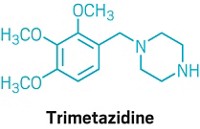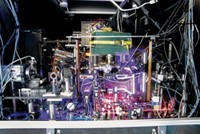Advertisement
Grab your lab coat. Let's get started
Welcome!
Welcome!
Create an account below to get 6 C&EN articles per month, receive newsletters and more - all free.
It seems this is your first time logging in online. Please enter the following information to continue.
As an ACS member you automatically get access to this site. All we need is few more details to create your reading experience.
Not you? Sign in with a different account.
Not you? Sign in with a different account.
ERROR 1
ERROR 1
ERROR 2
ERROR 2
ERROR 2
ERROR 2
ERROR 2
Password and Confirm password must match.
If you have an ACS member number, please enter it here so we can link this account to your membership. (optional)
ERROR 2
ACS values your privacy. By submitting your information, you are gaining access to C&EN and subscribing to our weekly newsletter. We use the information you provide to make your reading experience better, and we will never sell your data to third party members.
Education
Newscripts
by BY K. M. REESE
January 12, 2004
| A version of this story appeared in
Volume 82, Issue 2
Elements quiz based on C&EN
Richard S. Greeley writes from St. Davids, Pa., that his grandson found a practical use for the recent exposé on the periodic table (C&EN, Sept. 8, 2003). The grandson, Owen S. Greeley, is a sophomore at Hammond High School in Howard County, Md., and a first-year chemistry student. He is also on the school's "It's Academic" team. Grandpa Greeley says Owen used the C&EN issue on the elements to create a quiz designed to confound a competing team. The quiz comprises 10 questions; here are three of them:
* With the unique ability to reflect nearly 100% of light that falls on it, this element has the highest electrical conductivity of all metals. It is also necessary, according to myth, for defeating a lycanthrope.
* This heaviest nonradioactive element is also the most diamagnetic metal. Two of its compounds have been extensively used in gastrointestinal medication such as Pepto-Bismol.
* This element's first documented use is by the ancient Egyptians. Despite its strong toxicity, it has been frequently used in medicine, and in recent years it was recognized to be extremely useful in the treatment of deadly parasitic tropical diseases such as visceral leishmaniasis.
The senior Greeley does not report how the competing team came out on the quiz.
Five years of no leap seconds
Timekeepers at the National Institute of Standards & Technology (NIST) say they haven't had to insert a leap (or extra) second into their timescale for five years. The reason: The rate of the Earth's rotation has increased since 1999.
NIST introduced the first atomic clock in 1949, and the world switched to the current system of atomic timekeeping in 1972. From then until 1999, the timekeepers added 22 seconds to the world's time, which is measured by the Earth's spin, to keep it synchronized with atomic time, or vice versa. Since then they've had to add nothing.
Time experts are not sure why this should be so, but they have some ideas. Thomas R. O'Brian, who heads NIST's Time & Frequency Division, Boulder, Colo., says the speed of the Earth's rotation in the long term has tended to slow, but not during the past five years. The reasons, O'Brian suggests, include changes in the motion of the Earth's core, the effects of ocean tides and weather, and changes in the shape of the Earth's magnetic field. He says most scientists expect the Earth's spin to continue to slow in the future. O'Brian says: "The Earth's rotation rate has been the primary clock for nearly all of human history. ... Only in the last 50 years have we had clocks accurate enough to measure changes in the Earth's spin and rotation rate."
Armagnac helps foil blood clots
Nicholas Moore at the University of Bordeaux, in France, finds that drinking the grape-based brandy Armagnac in moderation helps to prevent blood clots. Armagnac is produced in southwestern France, where the French Paradox is most prominent. The French Paradox features a relatively low cardiovascular mortality rate among people whose habits would appear to dictate otherwise.
Armagnac acts something like aspirin in helping to reduce clotting, say Moore and his colleagues. They attribute its effect to its high content of antioxidant-rich tannins (polyphenols). Armagnac is aged at least several years, much longer than red wine and many distilled spirits, in barrels made of a rare type of black oak. Moore says, "Our research suggests that natural chemicals from tannins, which are highly concentrated in Armagnac, can be beneficial to heart and circulatory health."
People in southwestern France drink more Armagnac than people elsewhere, but not more wine, and live, on average, two years longer than people in other parts of France. Armagnac's medicinal properties have long been recognized, according to the Bureau of Armagnac. In 1313, for example, Cardinal Vital Dufour specified 40 health-related properties of the brandy in a book now housed in the archives of the Vatican.
The brandy is produced on small estates in Gascony immortalized in the Alexandre Dumas novel "The Three Musketeers."








Join the conversation
Contact the reporter
Submit a Letter to the Editor for publication
Engage with us on Twitter